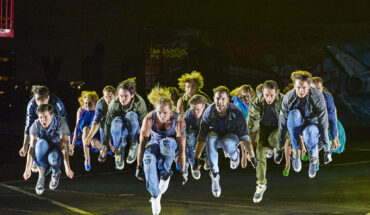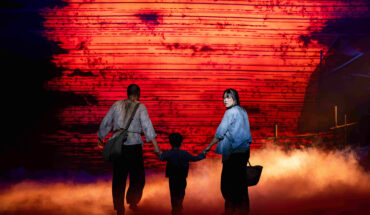We were looking forward to it a full year ago. Now, after more anticipation than we could ever have imagined in a pre-Covid world, La Traviata has finally arrived to Sydney Harbour and does not disappoint. It is a spectacle of epic proportions well worth the wait.
Starting with the red carpet arrival, opening night was a star-studded affair. I personally spotted the likes of Tony Abbott, Alan Joyce, Sam Neil, Carla Zampatti, and Jules and Cam from Married at First Sight. The sparkle of the celebrities in their fabulous attire was only surpassed by the stupendous centrepiece of Brian Thompson’s spectacular set, a nine metre by nine metre chandelier with 10,000 crystals, weighing in at a whopping 3.5 tonnes. The harbour stage, more than twice the size of any Australian indoor stage, boasts arguably the world’s most spectacular and recognisable city backdrop, with the harbour bridge, the opera house and Sydney tower all reflecting in the calm, glassy water of a perfect spring evening.
Continuing the theme of glamour and excess are Tess Schofield’s 1950s costumes and Shannon Burns’ dazzling choreography. And to top it all off there are the traditional fireworks that light up the night sky at the end of the first act. The whole first act is one heady hedonistic ride, fuelled by flowing champagne and famous hit after famous hit. It could end there, with the ‘Brindisi’ and ‘Sempre Libera’ ringing in our ears, and we would all go home on a high. Alas, this brings me to my one peeve when it comes to Handa Opera on Sydney Harbour: it peaks too soon. After the climax of the two big hits and fireworks, there is nowhere to go but down. For two more acts. This, I must note though, is not a directorial fault, but rather the natural slope of the plot and the music, which follow Violetta from being the life of the party, through abandonment and illness, to her inevitable demise. It’s a bit of a downer, literally.
Giuseppe Verdi based La Traviata (The Fallen Woman) on a play by French writer Alexandre Dumas, best known for his novels The Count of Monte Cristo and The Three Musketeers. The action follows Violetta, a beautiful, carefree Parisian courtesan who gives up her life of freedom, pleasure and luxury for true love, only to succumb to illness and lose all in a sequence of tragic turns. It’s a story we all know well, whether familiar with the opera or not, as La Traviata has directly inspired various blockbuster films, including Moulin Rouge and Pretty Woman.
The character of Violetta was based on a real life courtesan who died just six years before La Traviata premiered. She was in fact loved and financed by Dumas. (Together, that is, with a whole host of famous patrons.) Charming, intelligent, and refined, she owned a library, played the piano, and spoke multiple languages. Like all courtesans, she could successfully mingle in polite society, but was notorious for ruining the reputations and fortunes of honourable men and their families. She was, hence, a fashionable but confronting figure for Verdi’s 19th century audience. Today, a glance at the colourful creatures promenading the opening night red carpet reveals that after nearly 170 years, she would still be at the height of fashion, although no longer causing an eyelid to bat.
Verdi’s score is expressive and exquisite from the get go, with the gorgeous and readily recognisable prelude setting the mood for what’s to come. The role of Violetta is one of the most demanding in all operatic repertory. The incredibly high pitched and quick paced coloratura of the aria ‘Sempre Libera’ requires a level of skill not every soprano has. Australian-Mauritian soprano Stacey Alleaume makes these florid passages sound easy and natural, her voice flitting and bubbling forth with coquettish fun, whilst nailing the technical aspect of the ornaments. On the other end of the spectrum, in her duets with lover Alfredo and his father Germont, the warmth and beauty of her voice come through with expression and emotion. Alleaume has also mastered the art of the consumptive gasp that adds drama and pathos without taking away from her vocal performance.
Alfredo is sung by Kosovar Rame Lahaj, whose warm and emotive tenor is well suited to Puccini’s romantic, lyrical numbers. Sadly, he had some microphone issues on opening night, with his volume fading out and then abruptly surging back in. A production of this magnitude, which involves performers wearing in-ear monitors to hear an orchestra they cannot see, is bound to face some small technical issues on opening night. Likely this has already been adjusted for the following performances. Baritone Michael Honeymoon, always a reliable and well-studied performer, makes Alfredo’s father as likeable as possible.
The Opera Australia Chorus and the Opera Australia Orchestra are sensational, as they literally always are. Please do not make the mistake of thinking the music is a recording – it is all live, with a 40-strong orchestra performing live from beneath the stage.
Handa Opera on Sydney Harbour is always a lavish affair and a special experience. It only comes around once a year, and this time it’s been two years. With all the effort and expense they go to, they never miss with a production. Expect to be impressed, and not just with the spectacle but also the artistic standard. This is certainly not a production you want to miss.
– Alicia Tripp
La Traviata is showing at Fleet Steps, Mrs Macquarie’s Point until April 25.
Purchase tickets now. The venue is accessible.
Disclaimer: Alicia Tripp was an invited guest of Opera Australia
Photo credit: Prudence Upton



